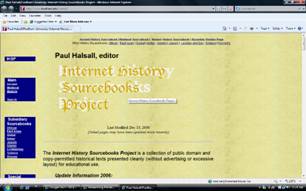Researching Primary Sources Online
Pamela AuCoin
As a history teacher, I have spent hours and hours finding the perfect document to complement my lesson. After a while, managing messy binders and at least ten different sourcebooks becomes frustrating. Furthermore, teachers risk violating copyright laws – not to mention frustrating school aides – with too many photocopy requests. Now, with the web, there is little need to dig—there are excellent comprehensive sources online.
A favorite is through Fordham University. http://fordham.edu/halsall/. This site covers topics from ancient history to the present day on every continent, including the history of gay rights and women's rights.

Teachers may or may not assign a complete document. Usually, I cut and paste excerpts. A classroom favorite is from Suetonius' history of the Roman Emperor Caligula. Instead of printing five pages, I usually copy and paste the following:
XVIII. He gave several gladiatorial shows, some in the amphitheater of Taurus and some in the Saepta, in which he introduced pairs of African and Campanian boxers, the pick of both regions. He did not always preside at the games in person, but sometimes assigned the honor to the magistrates or to friends. He exhibited stage-plays continually, of various kinds and in many different places, sometimes even by night, lighting up the whole city. He also threw about gift-tokens of various kinds, and gave each man a basket of victuals. During the feasting he sent his share to a Roman eques opposite him, who was eating with evident relish and appetite, while to a senator for the same reason he gave a commission naming him praetor out of the regular order. He also gave many games in the Circus, lasting from early morning until evening, introducing between the races now a baiting of panthers and now the manoeuvres of the game called Troy; some, too, of special splendor, in which the Circus was strewn with red and green, while the charioteers were all men of senatorial rank. He also started some games off-hand, when a few people called for them from the neighboring balconies as he was inspecting the outfit of the Circus from the Gelotian house.
Citation: Ancient History Sourcebook:
Suetonius (c.69-after 122 CE):
De Vita Caesarum: Caius Caligula
(The Lives of the Caesars: Caius Caligula), written c. 110 CE
By assigning just a portion of the text, students are still exposed to a primary source, without being overwhelmed by translated writing composed during the first century. Teachers can easily create handouts to distribute, or even (when possible) to project on a smartboard or save electronically on the school website.
Another resource I use is Kuwait's Constitution from 1960. I provide a handout, but for this project, I assign the text as part of a jigsaw group assignment: http://servat.unibe.ch/law/icl/ku00000_.html
Keep in mind: primary sources include more than just written materials. Differentiate your sources to include historic footage from documentaries, photographs, songs, and recordings. This ensures that all learners’ styles are addressed.
Some other favorite links to primary and secondary sources:
The National Archives: http://archives.gov/
Then Again Primary Source Index: http://thenagain.info/thenagain/Sources/SourcesIndex.htm
A very diverse list of sources, such as selections from the Qu'ran, Hammurabi's Code, the works of Aristotle and Frederick Douglass
Library of Congress-Online Catalog: http://catalog.loc.gov/
Footnote American History documents: http://footnote.com/
(Note: not all of these documents are available for free.)
18th Century Letters and Correspondence
http://history1700s.com/etext/blletters.shtml
A collection of 18th century letters from authors like Jonathan Swift, Benjamin Franklin, and Thomas Jefferson
BBC History: World Wars in depth: Child Survivors of the Holocaust
http://bbc.co.uk/history/worldwars/genocide/holocaust_survivors_gallery.shtml
Collection of photos and recordings of child victims of the Holocaust.
BBC History: World Wars in depth
http://bbc.co.uk/history/worldwars/
The BBC has an impressive collection of photographs and recorded speeches during the 20th century world wars. The site also includes visually stunning interactive videos of the battlefields and concentration camps. Strongly recommended.
Do
you have a comment or suggestion? E-mail
Pamela
|